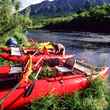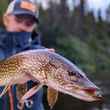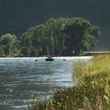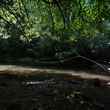In Simple Nymphing: Part 1, I focused on several basic nymph fishing truths and then delved into the easiest and most effective way to set up a nymphing rig. To summarize those truths:
First, you need to present appropriate flies to a trout, or to likely looking water, at the right depth, and without drag or unnatural movement.
Then you need to detect the strike and set the hook before the fish expels your nymph.
That’s nymphing in a nutshell. We can make it far more complicated, of course, but there’s really no reason to add additional levels of complexity unless we’re looking for a challenge or we’re drawn to complexity for its own sake.
Since we’ve already covered our simple nymphing rig in Part 1, let’s shift our attention to presentation and hook sets. And let’s start out by looking at the nymphs themselves.
Nymphs
Nymphs survive and grow to adulthood in large part by living in places that limit predation. It’s hard for a trout to eat a nymph that has burrowed into mud or gravel, or that is living under a rock or clinging to aquatic vegetation. Consequently, most trout key on nymphs that have become dislodged and are floating downstream, or that are drifting in the current prior to their emergence. Which, if you think about it, means that our flies need to mimic that natural drift.
The Drift
If you pick up a rock and throw it into a creek, it will sink. The rate it sinks, and where that rock ends up, will depend on things like its shape, its density, the water’s depth and speed, etc. The same is true of our weighted flies. Yet we don’t want our flies to simply drop through the water column and lodge on the bottom. Instead, we want them to sink to a certain depth, then drift naturally with the current through the exact area where we expect the fish to be waiting. We don’t need to maintain that natural drift for long — we don’t require a 30’ drift to catch trout with nymphs — but we do want a perfect drift when we reach the spot where the trout is holding.
We achieve this by choosing flies that are the right weight for the water speed and depth, and by manipulating our line and leader.
If our drift begins with our line, strike indicator and leader downstream of our fly, we control the fly’s descent through the water column. (Assuming, of course, that we’re not in an eddy or another funky current.) If our line, strike indicator and leader are upstream of our fly, the fly will sink more rapidly. So it’s up to us to determine when we want our fly to drop like a stone and when we want our line, strike indicator and leader to counter-balance our nymph’s weight and either slow its descent or allow it to float naturally.
In a very real sense, every single drift has three parts:
- The fly hits the water and starts to sink. We can control the sink rate by choosing the size, shape and weight of our fly, as well as whether the line, indicator and leader are upstream or downstream of the fly.
- The fly reaches the desired depth, levels out and drifts naturally. This portion of the drift is short — anywhere from a foot to maybe eight or ten feet — but it’s the point when our odds for success go way, way up. We achieve this natural drift by using the line, strike indicator and/or leader to support the fly in the water column.
- The fly reaches the end of the drift and rises up through the water column as the line and leader come tight. If we control this ascent so that it mimics emerging mayflies or caddis, it can be awfully effective. (If you’re interested, you might want to study techniques like the Leisenring Lift.)
Good anglers don’t simply wade out into the river and make an endless array of basic water-loaded casts, modified by an equally endless number of basic mends. That’s a recipe for maximum drudgery and far fewer fish. Instead, we look for trout feeding down in the water column, or for a prime spot where we expect the fish to be waiting, and then we determine our approach, and where we want to stand, and what flies we need, and what type of cast we’ll make, and what type of mend — if any — we want to incorporate.
Our goal isn’t to cover as much water as humanly possible. It’s to pick out prime spots and have our nymph drift through those very specific areas in a natural manner. Maybe that means that we’re lobbing a couple of nymphs upstream, or up and across, and then following up the cast with several well-executed stack mends. Maybe it means that we’re making a reach cast, or a combination reach/pile cast, across the current to a prime spot that’s down and across from our position. Every situation is different and every new spot requires a thoughtful approach seasoned with both a healthy dose of awareness and an accurate understanding of what we’re trying to achieve.
We’re focused on getting our nymph — or nymphs — to float naturally past a feeding trout. That’s it — at least until a fish grabs our fly and it’s time to set the hook.
Hook Sets
When it comes to hook sets, different styles of fly fishing require different approaches. With streamers, we feel the take. With dry flies, we see it. Yet neither of those work particularly well with dead-drifted nymphs. There are exceptions, of course, but if you wait to see or feel the take when you’re fishing nymphs, you’re going to miss fish. Lots of fish.
If we’re fishing nymphs, we have to intuit, based on our senses and our inherent awareness, that the fly has stopped. Then we set the hook immediately in the hope that a fish is responsible.
Simple, right?
Back when I was guiding fly fishers on a daily basis, I used to tell my clients to set on everything. If the line or indicator or leader stopped, or paused, or acted funny, or did anything even remotely out of the ordinary, they needed to set the hook. Every single time. Without fail. Folks who listened caught way more fish than those who didn’t.
It helps to anticipate the hook set; to imagine where the fish is holding, and where the fly is in relation to that spot, and then to be ready when the two converge.
It also helps — and this is especially true for hesitant anglers — to commit to setting the hook at some point during every single drift. It’s a great way to get dialed in, and if you’re fishing well you’ll start to notice that you’re setting the hook and catching fish when you weren’t even positive you saw something to indicate the strike. The best nymph fishers I know set on instinct, and on clues that are so minute that they don’t always register in the conscious parts of our minds.
None of this is complicated. Since we don’t typically feel or see the strike, and since trout don’t tend to hold onto our nymphs for very long, we have to be both intuitive and proactive with our hook sets.
I’d estimate that most anglers miss — in other words, they don’t even notice — 90% of their strikes. To make matters worse, a trout who just mouthed your fly and spit it back out is unlikely to eat that same fly again. So if we’re dead-drifting nymphs and not setting the hook when we should, we’re literally teaching the trout to ignore our offerings in the future.
Wrapping Up
Simple nymphing is, for lack of a better term, simple. It’s also incredibly effective. You use a simple rig, you focus on getting a dead drift through the spot where the trout is holding, and you set the hook on anything that might possibly be a fish.
That doesn’t mean, though, that simple nymphing is easy. You have to be able to read the water, and wade where you need to go, and make a variety of casts — including reach casts — and get a great, controlled drift. And then you have to fish like a predator and rely on instinct and awareness to set the hook every single time your intuition and/or awareness tells you to do so.
Long story short, this type of nymphing is a great tool to add to your fly fishing arsenal. It doesn’t require specialized gear or specialized knowledge, and it’s easy enough to switch from dry flies or streamers to a simple nymphing rig.
It’s also deadly, which is a pretty serious bonus.
Perhaps the best thing about simple nymphing, though, is that it helps take our fly fishing skills to a level most anglers will never approach. And that’s truly important, because the better we fish, the more fun we’ll have on the water.

































Comments
Simon replied on Permalink
I worry I am scaring fish by setting to often. Is that true?
Todd Tanner replied on Permalink
In an ideal world, you'd set on every strike -- and only on actual strikes. But since that's not an option, it's far better to set too often than not enough. Don't worry about scaring the fish with your hook sets.
Charles replied on Permalink
Tightline nymphing lets one feel the hookset.
Pages